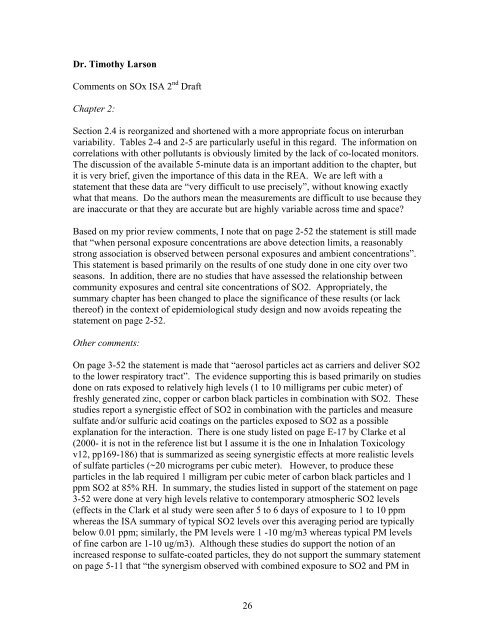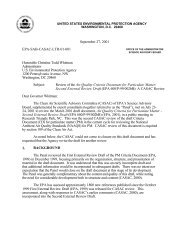(CASAC) Peer Review of EPA's Integrated Science Assessment
(CASAC) Peer Review of EPA's Integrated Science Assessment
(CASAC) Peer Review of EPA's Integrated Science Assessment
Create successful ePaper yourself
Turn your PDF publications into a flip-book with our unique Google optimized e-Paper software.
Dr. Timothy LarsonComments on SOx ISA 2 nd DraftChapter 2:Section 2.4 is reorganized and shortened with a more appropriate focus on interurbanvariability. Tables 2-4 and 2-5 are particularly useful in this regard. The information oncorrelations with other pollutants is obviously limited by the lack <strong>of</strong> co-located monitors.The discussion <strong>of</strong> the available 5-minute data is an important addition to the chapter, butit is very brief, given the importance <strong>of</strong> this data in the REA. We are left with astatement that these data are “very difficult to use precisely”, without knowing exactlywhat that means. Do the authors mean the measurements are difficult to use because theyare inaccurate or that they are accurate but are highly variable across time and space?Based on my prior review comments, I note that on page 2-52 the statement is still madethat “when personal exposure concentrations are above detection limits, a reasonablystrong association is observed between personal exposures and ambient concentrations”.This statement is based primarily on the results <strong>of</strong> one study done in one city over twoseasons. In addition, there are no studies that have assessed the relationship betweencommunity exposures and central site concentrations <strong>of</strong> SO2. Appropriately, thesummary chapter has been changed to place the significance <strong>of</strong> these results (or lackthere<strong>of</strong>) in the context <strong>of</strong> epidemiological study design and now avoids repeating thestatement on page 2-52.Other comments:On page 3-52 the statement is made that “aerosol particles act as carriers and deliver SO2to the lower respiratory tract”. The evidence supporting this is based primarily on studiesdone on rats exposed to relatively high levels (1 to 10 milligrams per cubic meter) <strong>of</strong>freshly generated zinc, copper or carbon black particles in combination with SO2. Thesestudies report a synergistic effect <strong>of</strong> SO2 in combination with the particles and measuresulfate and/or sulfuric acid coatings on the particles exposed to SO2 as a possibleexplanation for the interaction. There is one study listed on page E-17 by Clarke et al(2000- it is not in the reference list but I assume it is the one in Inhalation Toxicologyv12, pp169-186) that is summarized as seeing synergistic effects at more realistic levels<strong>of</strong> sulfate particles (~20 micrograms per cubic meter). However, to produce theseparticles in the lab required 1 milligram per cubic meter <strong>of</strong> carbon black particles and 1ppm SO2 at 85% RH. In summary, the studies listed in support <strong>of</strong> the statement on page3-52 were done at very high levels relative to contemporary atmospheric SO2 levels(effects in the Clark et al study were seen after 5 to 6 days <strong>of</strong> exposure to 1 to 10 ppmwhereas the ISA summary <strong>of</strong> typical SO2 levels over this averaging period are typicallybelow 0.01 ppm; similarly, the PM levels were 1 -10 mg/m3 whereas typical PM levels<strong>of</strong> fine carbon are 1-10 ug/m3). Although these studies do support the notion <strong>of</strong> anincreased response to sulfate-coated particles, they do not support the summary statementon page 5-11 that “the synergism observed with combined exposure to SO2 and PM in26
















